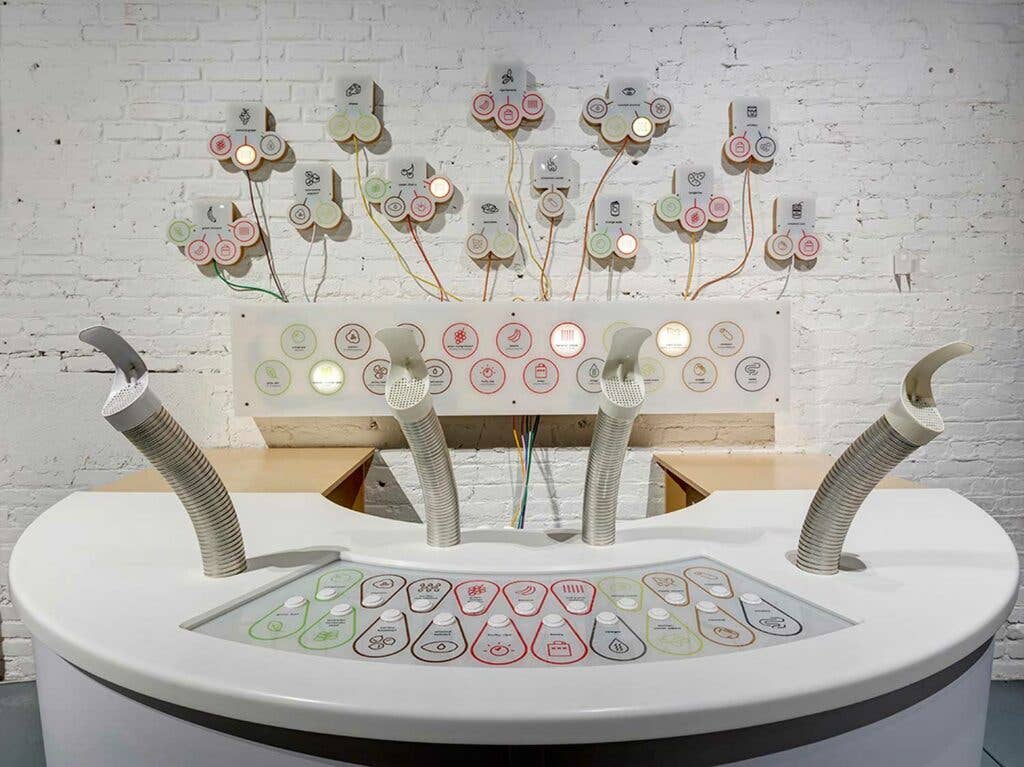
The Rise of the Experiential Food Museum
Why are there so many of them, and what—if anything—do they have to each us about our food systems?
Since their inception, many of the most famous museums, from the Metropolitan Museum of Art to the Louvre, have displayed centuries-old cookware, still-life paintings of fruits swathed in supple velvet fabrics, and portraits of dignitaries at dinners that defined the course of history to come. However, the food museum, specifically—a hybrid space devoted entirely to the cultural phenomena of putting food on the art space's pedestal—has become an unavoidable trend. Today there is the Currywurst Museum in Berlin, the Shin-Yokohama Ramen Museum in Yokohama, Japan, and the JELL-O Museum, in Le Roy, New York, just to name a few. But what does it mean to bring our daily sustenance to the forefront in a museum setting?
These particular food-art spaces go against the classic idea of how a museum is often designed, which puts special attention on how the works physically engage with the museumgoer. As art theorist Brian O'Doherty once described in his seminal work, Inside the White Cube: The Ideology of the Gallery Space, the design of these modern art spaces are purposefully sterile and decontextualized: "A gallery is constructed along laws as rigorous as those for building a medieval church...The wooden floor is polished so that you clink along clinically, or carpeted so that you pad soundlessly, resting the feet while the eyes have at the wall."

By contrast, food museums, like the millennial pink Museum of Ice Cream (which has toured San Francisco, Los Angeles, and Miami), or Dave Arnold's New York Museum of Food and Drink (MoFAD) with its interactive sensory exhibits, harken back to the joy of how we first experienced art spaces as children. In many of these environments, you'll find tactile elements that engage your senses, more akin to a children's science museum than a modern art museum. At the Museum of Ice Cream, you can dip yourself into a swimming pool filled with billions of plastic sprinkles. Museum of Food and Drink's exhibit called Flavor: Making It and Faking It explored the science behind flavor perception and featured a machine that released unique food smells, perhaps the most influential sensory experience in food. In October, New York will even get The Pizza Museum, (whose marketing is going the route of sexualizing gluttony) and will feature, among other things, an archive of pizza boxes from around the world.
In spaces like these, guests are encouraged to interact with the exhibits, rather than be reprimanded for stepping a little too closely to the display. But more than that, these spaces encourage learning through a variety of senses beyond plain sight, which marks a dramatic shift in how people with disabilities can experience a museum.

But despite the fun, the sprinkles and the giant currywurst couches, there’s something a little more serious at play in some of these food museums. They’re usually the product of “experiential marketing,” a scheme of sorts hatched up by corporations to create a lifestyle out of their brand, which typically means hanging out on furniture made by cool artists while drinking well-brewed coffee. It’s a sneaky, modern-day advertisement that sometimes doesn’t even need to display a logo to get the message across.
At its best, experiential marketing operates in spaces like the incredibly beautiful A/D/O in New York's Greenpoint neighborhood: a community space focused on design, urban planning, and architecture, which also houses Norman, a Nordic-forward restaurant from Michelin-starred chef Fredrik Berselius and restaurateur Claus Meyer. A/D/O was entirely created by MINI automotives, but you're not likely to find any evidence of their brand throughout the space.
At its worst, it's the heavy-handed Kellogg's cafe tourist trap in Union Square, which opened in late 2017.
Tacking the word “museum” onto a space’s name has not only become a trend, but a careful tactic with clear economic return. In a recent feature for HyperAllergic, the author writes, “Museum is a loaded word. Organizations like The American Alliance of Museums and the International Council of Museums (ICOM) uphold rigorous standards for accreditation; the official designation “museum” can increase credibility and access to government and private grants.”
The oversaturation of naming a space "museum" is particularly apparent in an era where the designs behind restaurants, retail stores, and any sort of public space are heavily influenced by what their creators think will perform well on Instagram. These spaces, though they use the egalitarian title of "museum," are almost all for-profit endeavors. Coming this summer to New York City, the Museum of Candy is created by Sugar Factory: continuously one of the most Instagrammed restaurants in the world.

But the issue with this wave of food museums isn't that they're colorful and playful places where guests are encouraged to snap a photo or two for their social media feeds. The problem is that while many of these food museums tout themselves as being more democratic and casually interactive than the classic "white box" museum, they fall privy to steep ticket prices, and consistently lack context or acknowledgement for the complex systems through which the foods or cuisines they focus on actually come to exist in our society. The Museum of Ice Cream, for example, makes no mention of the systems in which dairy and sugar exist: not the varied ways sugar affects our bodies and brains, the rising number of millenials with diabetes, nor the distressing conditions of dairy farms.
And sometimes, that impulse toward an endlessly Instagrammable moment belies a greater lack of awareness for its material implications. The Museum of Ice Cream was fined for pollution in January at their Miami pop-up, as guests brushed off their plastic sprinkles onto the city's streets. According to a statement, at least, they appear to be working on a biodegradable alternative.

Maybe it's too much to ask these food art spaces to engage with culture and enlist the careful curation and criticism we come to expect from modern museums. My own pop-up food and art space, Scratch 'n Sniff Studio, uses roaming community-oriented experiences and atypical art environments to shed light on issues of food justice. What would be the difficulty for these other for-profit installations to, say, open their spaces up to school groups, or non-profit food organizations like Edible Schoolyard and Teens for Food Justice, for free, once a week?
Spaces like MoFAD, however, are already incredibly positive leaders of this new kind of blueprint for food education. In their current program "Chow," they deal with Chinese food in a way that is sensorial, edible, and yes, fun (there’s a fortune cookie machine with which MoFAD attendees can create their own fortune), and there’s also a chef-in-residence preparing authentic Chinese dumplings in the middle of the gallery. Beyond that, the exhibit tells an important story of immigration in America: It follows the Chinese Exclusion Act (which feels particularly timely under our current administration’s horrific Muslim ban), and digs into the appropriation of “ethnic” cuisine, an ongoing public conversation.
One could argue that food museums like these exist so that we can have an escape, a moment of silliness and fun when so much of our world seems to be crumbling around us. Sometimes we just want to visit The Egg House and appreciate a good ol’ anthropomorphized egg without thinking about our industrialized food system or the conditions the hen that laid it was living in.
But at this particular turning point, when our world population is growing higher and higher, yet more food than ever is wasted every day, making art out of food is inherently a political act, and should be considered as such. We should never think to aestheticize hunger without reason.
The food museum represents a growing consumer desire to have more interactive and engaging experiences with art—and who wouldn’t want to get behind that? But they have the potential to be more, to be conduits to create transparency about the state of our food system through creative design and programming. We just need to start using these museum spaces more in this way: to use social media to spread the word while doing our research along the way.
Keep Reading
Continue to Next Story










